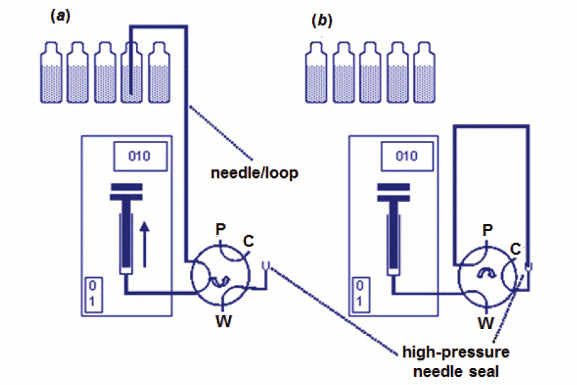In the last instalment of (HPLC Solutions #120) we looked at one popular autosampler design, the push-to-fill autosampler. Now we’ll turn our attention to the other most popular design, which I call needle-in-loop.
At first glance, it might appear that the two designs are the same, but if you compare Figure 1 with the figure in #120, you’ll see there are differences. We still have the pump (P) connected to the column (C) during the load phase, and there is a waste line (W). The big difference is that in the needle-in-loop design, the needle is part of the loop. Another way of thinking of this is that the needle has a volume of 100 μL. In action, the autosampler works like this. To pick up sample, Figure 1(a), the needle is aligned in the sample vial, lowered to near the bottom of the vial, and the desired amount of sample is removed using a motorized syringe mechanism. This is very similar to the push-to-fill action. However, the sample stays in the needle/loop and does not go into additional transfer tubing. Next, Figure 1(b), the needle is inserted into a high-pressure seal connected to the injection valve, thus completing the connection of the loop across the injection valve. To make the injection, the valve is rotated and the pump (P) pumps solvent through the needle/loop to the column (C). The beauty of the needle-in-loop autosampler is that, because the tip of the needle is in the mobile-phase flow path, 100% of the sample is injected. With the push-to-fill design, loss of some sample in the transfer tubing and connections is typical. So if the sample volume is very small or the sample is very valuable, no sample is wasted with the needle-in-loop autosampler.
The weak part of the needle-in-loop autosampler is the high-pressure needle seal. This seal must withstand the full pressure of the HPLC system, which may be as high as 6000 psi (400 bar) for conventional HPLC systems. With higher-pressure UHPLC systems, use of this design can be very challenging. Different autosamplers use different seal designs, so yours may have an adjustment if the seal leaks, or you may have to replace the seal. Also, because the needle and loop are a single component, the price usually is higher than the push-to-fill design that uses a simpler and less expensive needle. With the push-to-fill’s conventional sample loop, you can install any size loop that will fit, and make your own custom-volume loops if you like. The needle-in-loop has a limited range of loop sizes, with 100 μL the most common, and used in the partial-fill mode.

Figure 1
All autosamplers provide wash solvent capability so that the needle, and sometimes other passages, can be washed between injections to reduce carryover. Rinsing inside, as well as the outside surfaces of the needle and the needle seal is common. As a general rule, the wash solvent should be stronger than the mobile phase (more organic than the mobile phase in reversed-phase operation). If pH control is needed to help dissolve sample or matrix residues, I prefer to use volatile additives, such as formic acid for low pH or ammonium hydroxide for high pH. specific pH and buffer control seldom is needed. The reason I like to use volatile additives is that every autosampler I have ever seen will leak or drip at some point. If you use phosphate buffer or sodium chloride additives, those drips will leave residues that will have to be cleaned up – volatile additives will evaporate and not cause such problems. And finally, remember to change the wash solvent and replace the reservoir with a clean one on the same replacement cycle that you use for your mobile phase.
This blog article series is produced in collaboration with John Dolan, best known as one of the world’s foremost HPLC troubleshooting authorities. He is also known for his research with Lloyd Snyder, which resulted in more than 100 technical publications and three books. If you have any questions about this article send them to TechTips@sepscience.com




